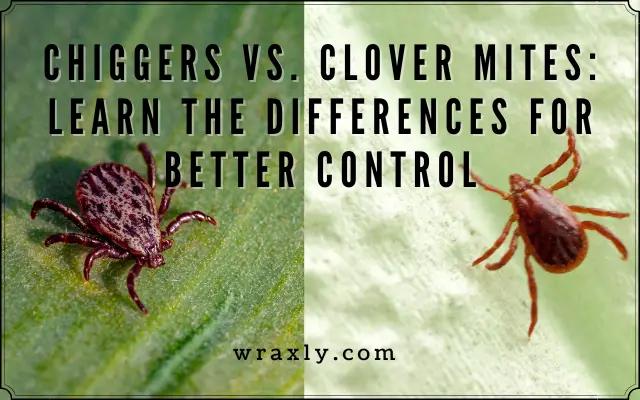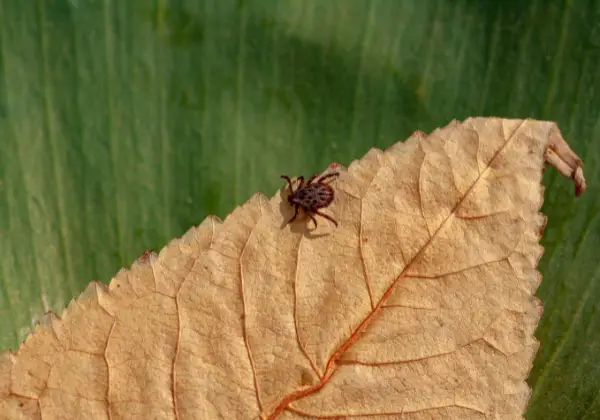Identifying the difference between chiggers vs clover mites is the crucial first step in figuring out the best way to control them.
Chiggers and clover mites are two little red insects that are often confused with one another, but the damage they cause is different. Chiggers normally feed on people and other mammals, whereas clover mites prefer to feast on shrubs and other plants.
So, in this article, we’ll go over the differences between chiggers vs. clover mites so you can control your infestation. So, let’s get started!

Chiggers vs. Clover Mites: What’re the Differences?
One question we get a lot is, “are clover mites chiggers?”. The short answer is: No, clover mites are not chiggers.
If you want the long answer, here are some key differences between these two pests:
1. How They Look
Because they’re so small, it’s challenging to tell the differences between chiggers and clover mites. However, there are a few key differences in their physical appearances.
For one, clover mites are typically reddish-brown, while chiggers are more deep red in color.
Furthermore, chiggers are significantly smaller than clover mites, measuring around 1/60th of an inch as opposed to 1/20th of an inch for the clover mite. While you’ll still be able to see clover mites with your naked eye, you’ll need magnification to see their physical features.
Finally, chiggers have six legs, while clover mites have eight. Clover mites have a pair of front legs that are significantly longer than the other pairs, and they have ovular-shaped bodies. Adult Chiggers, on the other hand, have almost Strawberry shaped bodies.
2. Where They Live
You’ll find Clover Mites in areas with short grass, along the perimeter of your property, and close to points of entrance, including doors, windows, gaps, and fissures. In colder temperatures, they’re on the lookout for warm shelters. That’s when they may creep inside and infest houseplants.
On the other hand, you’re very unlikely to find Chiggers in your home. They don’t enter indoor areas; they’re only found outdoors. They like fields with shredded soil or overgrown, high grassy, damp forested regions. Additionally, you may find them close to rivers, lakes, and wetlands.

3. How They Move
Clover mites can move quickly in a straight line. They will often be seen running along walls or windows. Clover mites can also jump, which helps them to escape predators or to get to food sources.
Chiggers, on the other hand, move in a more erratic pattern. They will often be seen crawling on the ground or on plants. Chiggers can also climb, which helps them to get to places where they can find food.
Clover Mites are more likely to invade homes in large numbers than Chiggers. Clover mites can also cause staining on walls and fabrics when crushed.
4. How They Bite
The bite of a chigger is different from the bite of a clover mite. For one, chiggers attach themselves to their host with mouthparts and suck their host’s blood. If you’re bitten by a small red bug in the house, it’s most definitely by a larval Chigger (because adult Chiggers don’t bite). You’ll notice these bites around your ankles, waistline, and back of the knee.
Clover mites, on the other hand, do not bite their host (though they’re the one who invades indoors). Instead, they puncture the host’s skin with their mouthparts and suck out the host’s body fluids.
The difference in how these two types of mites bite their host can have different consequences. Chiggers can transmit diseases to their host through their bite, while clover mites generally do not.
In addition, chigger bites can be quite painful and often result in an itchy, red welt. Clover mite bites, on the other hand, are usually not painful and do not usually result in any irritation.
5. When You See Them
Each season has its own unique weather conditions, which can affect the type of insects that are active.
Chiggers are most active in the spring and summer months, when the weather is warm and humid, while clover mites are more likely to be seen in the fall and winter months when the weather is cool and dry.
How Do You Get Rid of Chiggers or Clover Mites?
Although Chiggers and Clover Mites are both small red beetles, they’re physiologically different pests that require unique approaches to treatment.
How to Control Chiggers?
There are a few things that you can do to control chiggers.
First, you can avoid areas where they are likely to be found, such as tall grasses and weeds. If you are going to be in an area where chiggers are likely to be found, you can wear long pants and a long-sleeved shirt to keep them from getting on your skin.
You can also apply a repellent to your skin that contains DEET or permethrin.
If you have chiggers in your home, you can get rid of them by vacuuming them up or by treating your home with an insecticide. You can also prevent them from coming into your home (with you) by keeping your yard free of tall grasses and weeds.
What If You’re Bitten?
If you do get bitten by chiggers, there are a few things that you can do to relieve the itching.
You can apply a topical antihistamine or a steroid cream to the bites. You can also take an oral antihistamine. If the itching is severe, you can take a short course of oral steroids. Remember, all these must be done under the supervision of licensed medical practitioners or pharmacists if they are prescription only medication drugs.
How to Control Clover Mites?
If you’re dealing with a clover mite infestation (which can be difficult to control), there are a few things you can do to get rid of them.
One option is to vacuum them up. This will remove them from your home, but it’s not a long-term solution. Clover mites will eventually come back.
Another option is to use a pesticide. There are many pesticides available that will kill clover mites. Be sure that they contain permethrin, bifenthrin, diazinon, or chlorpyrifos.
Also, follow the directions. Some pesticides are more effective than others, so you may need to experiment to find the right one.
If you have a serious infestation, you may need to call a professional. A professional will be able to identify the source of the infestation and eliminate it. This is the best way to get rid of clover mites for good.
FOR FURTHER READING
- How to Get Rid of Gnats in a Vegetable Garden
- Organic Pest Control
- How to Get Rid of Clover Mites
- Do Spider Mites Live in Soil?
Final Thoughts on Chigger vs Clover Mites
Clover mites and Chiggers may look similar (just a small red bug in the house), but you must be able to identify their differences. With this “Chiggers vs Clover Mites” short guide, you’ll be easily able to identify what’s creating a nuisance on your property.
And with our tips on managing them, you can stop chiggers or clover mites from infesting your property fast and effectively!
Or in the worst-case scenario, if you can’t control either of these pests, contact a professional pest control company for assistance.

Darrell has a passion for gardening that he inherited from his father. Go here to read more about the influence his father played in his love for gardening. If you want to send Darrell a quick message, then visit his contact page here.

![How to Water Indoor Plants [Plant Care 101]](https://wraxly.com/wp-content/uploads/2021/03/How-to-Water-Indoor-Plants-Plant-Care-101-1200-1024x576.webp)

![Growing Plants from Cuttings [A Simple Guide]](https://wraxly.com/wp-content/uploads/2021/03/Growing-Plants-from-Cuttings-A-Simple-Guide-1200-1024x576.webp)